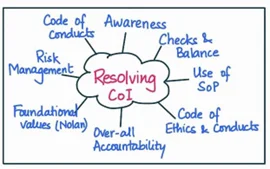Answer:
| Approach:
Introduction
Definition of conflict of interest.
Body
- Mention actual and potential conflicts of interest.
- Add examples to substantiate your views.
Conclusion
|
Introduction:
Conflict of interest refers to a situation where an individual’s personal interests or financial interests may influence their ability to make impartial decisions in their professional capacity.
Body:
Here are some examples of actual and potential conflicts of interest:
- Actual Conflict of Interest: An actual conflict of interest arises when an individual’s personal interests directly conflict with their professional duties.
- For example:
- A government official who holds shares in a company that is bidding for a government contract.
- A doctor who receives a commission from a pharmaceutical company for prescribing their drugs.
- A judge who owns shares in a company that is involved in a case before them.
- A police officer who receives gifts or favors from a suspect they are investigating.
- An auditor who is hired by a company to audit their financial statements, but also provides consulting services to the same company.
- Potential Conflict of Interest: A potential conflict of interest arises when an individual’s personal interests could potentially influence their professional duties.

For example:
- A financial advisor who receives a commission for recommending certain investment products to clients.
- A journalist who owns shares in a company they are reporting on.
- A lawyer who represents a client whose interests conflict with their own personal beliefs.
- An academic researcher who receives funding from a company that produces a product they are researching.
- A public official who has close personal or financial ties to a company that is seeking a government contract.
Conclusion:
In each of these situations, the individual’s personal interests could potentially influence their professional duties, creating a conflict of interest. It is important for professionals to be aware of these potential conflicts and take steps to manage them, such as recusing themselves from decision-making processes, disclosing potential conflicts to relevant parties, or seeking guidance from an ethics committee.
